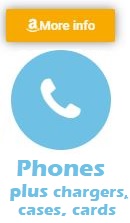Collier teachers navigate how to use, limit smartphones in class
If Amazon doesn't have a Whole Foods grocery near you, there are non-perishable groceries ( food that doesn't spoil) that Amazon can ship to you

You’ve upgraded and still have a functioning, if slow, smartphone. It’s got more life to it yet. Check out these innovative ways to re-use and recycle your old cell phone.
Kim Komando, for USA TODAY
Every student in Ian Sharp’s biology course has a Twitter page that compiles a year of making videos, taking pictures and learning course materials.
Their digital footprints were built by using smartphones at least once a week in class, a trend that Sharp plans to continue for years to come.
Sharp, who teaches at Barron Collier High School, said he’s trying to find new ways to use smartphones in his class so his students will see value in using them for learning.
“This generation is different,” Sharp said. “What I really want to do is provide them an opportunity to be creative. Everyone has a cellphone. I can have them easily engaged and I don’t have to spend any additional money.”
More: Photos and videos from college and high school graduations around Southwest Florida
Smartphones are accessible to most teenagers, who often bring them to schools. With freedom to regulate cellphones in their classrooms, most teachers are attempting to implement new ideas while balancing student distraction and district policies. Nationally, smartphone use in schools is a bit controversial.
In most cases, it’s left up to teachers and school administrators to develop their own process of when cellphone use is appropriate, so one class might use them and another might ban them.
In Collier, elementary and middle school students must have the phones turned off during school hours. High school students can use their phones during breaks and lunch for personal use.
Lee County School District’s Code of Conduct allows students to possess cellphones on school grounds, but only high school students can use their cell phones during non-instructional time.
Cellphone use is at the teacher’s discretion, like in Collier. Teachers can approve time for them to be used in a classroom activity or outside a classroom, according to the code of conduct.
Both districts list confiscation and detention as a possible disciplinary action for inappropriate use.
Sharp’s decision to teach with smartphones was approved by the Collier district, but the cellphone policy differs from class to class and school to school. He’s used cellphones in his class for three years.
His class started using Twitter at the beginning of the school year after parents approved their students’ accounts and the school district pushed teachers to give their classrooms a larger social media presence.
“I just like Twitter because I think it’s more likely that they’ll go to Twitter,” Sharp said.
He typically posts his assignments to Twitter, and his students post their work.
At least once a week, his class creates stop motion videos on different subjects, from evolution to pollination, to post to their Twitter pages. His class looks like a video production room on those days.
More: Congrats! Here are all of the 2019 Graduates of Distinction
Cellphones are everywhere
It’s no surprise that more kids and teens are using smartphones. They have more access to them now than ever before.
Some 95% of U.S. teens say they have or have access to a smartphone, according to the Pew Research Center. The center found smartphones to be common among all teens while computer use varies by household income.
Most teens have access to a smartphone, a trend that started to skyrocket about six years ago.
In a 2013 survey, Pew Research Center found 37% of all teens have smartphones.
Liz Kolb, a professor at the University of Michigan’s School of Education, said that while most students have cellphones, educators do not have a set plan for how to manage them.
“Cellphones are much more prevalent in schools, especially middle and high schools,” Kolb said. “More students have them than ever before, but the number of teachers that are using cellphones for actual learning activities … I would definitely not say it’s the majority of teachers that are.”
2018: Teacher said no cell phone during test. So naturally, teen brings record player
Kolb, who started studying cellphones in schools more than a decade ago, said teachers are in uncharted waters when it comes to cellphones. Many do not know what works and what doesn’t work and so operate by trial and error.
Sharp said it’s stressful for him to have a core class, which focuses on a year-end test and is required for students to graduate. He needs to get them motivated to learn course materials quickly. Right now, cellphones help that, he said.
“As much engagement as possible is really what’s best,” Sharp said.
Distracted learning
Not all teachers are as open to incorporating cellphones in their classrooms.
Gulf Coast High School teacher Kayla Fulghum said she allows her students to pull out their phones, but at select times.
“I feel like it holds their attention better if they do not have their phones,” Fulghum said.
Fulghum put a charging station in her room to encourage students to plug them in instead of using them during class time. She said it works wonders.
More: Collier schools, teachers union kick off contract negotiations
She’s trying to find a happy medium because she realizes how useful cellphones can be, she said.
“They’re (teachers) still grappling with the issues of how to use them effectively versus the distraction they bring,” Kolb said.
Teachers are trained on technology by the district and their schools at the beginning of the school year, Sharp said. Sharp said training focused more on social media than teaching with phones.
“Teachers have not been trained in how to use student cellphones effectively, so there’s a little bit of a fear because of the distraction that they do bring,” he said.
While millennials might be all grown up, a lot of them are still getting help from home. Buzz60’s Natasha Abellard has the story.
Buzz60
Most U.S. school districts have reversed bans
Kolb said she’s not surprised to hear some teachers keep cellphones away from students to keep them focused in class.
Distraction is why many different countries, states and school districts are divided on their purpose in a classroom setting.
Most notably, France banned smartphones from first to ninth grades earlier this year. Ontario, Canada’s largest province, will ban cellphones from schools starting next year.
When smartphones first came into the public eye, most school districts instituted bans. Kolb said many are now overturned.
NEA Today, a publication of the National Education Association, reported in 2016 that nearly 70% of school districts in the U.S. had reversed cell phone bans.
More: Collier educators, activists join march to ‘Save our Schools’
Fulghum said she worries about cheating, among other things, when cellphones are being used in class, but she tries to circle her room and prevent any bad behavior.
“This is a great tool, but we also have to have our morals and honesty,” Fulghum said. “There’s a time and a place, and sometimes they’re (students) just not old enough to realize that.”
‘It needs to be in jail’
Gulf Coast High School English teacher Kim Benedict has her students place their phones in “jail” at points during her class. Most of the time students don’t have them, she said.
Benedict turned a hanging shoe organizer into her jail. When students enter her classroom, they place their phones in individual plastic nets.
Once put away, students are not allowed to grab them until class ends or Benedict uses them for a lesson, which she said is not very common.
“I am wary of phones just because they can be such a big distraction,” Benedict said.
She believes that if you want kids to pay attention in class distractions need to be kept at a minimum or eliminated.
“This year, it’s working,” Benedict said. “I want to continually evolve. If other teachers are having good success I’m willing to kind of switch what I’m doing.”
More: Collier County high schools’ graduation rate increased again, to 91.9 percent
Students follow her protocols and phone jail rule, she said, and she rarely has discipline issues with cellphones. Both Sharp and Fulghum also said discipline is not an issue with phones in class.
Most teachers are figuring out what works for them because new media and technology arrive each year, Benedict said.
Sharp said distraction rears its head in his class too. It’s something all teachers deal with, he said.
At any point, one of Sharp’s students could receive a notification from Snapchat or other social media, which throws off their entire process, he said.
“It sounds great to use technology a lot, but it can be overkill,” Sharp said.
Read or Share this story: https://www.naplesnews.com/story/news/education/2019/05/20/collier-teachers-navigate-how-use-limit-smartphones-calss/3313871002/

 College Dorm and Apartment Cooking gadgets - if you change the sort settings on the Amazon page, it will show other items by price
College Dorm and Apartment Cooking gadgets - if you change the sort settings on the Amazon page, it will show other items by price

Source link

















